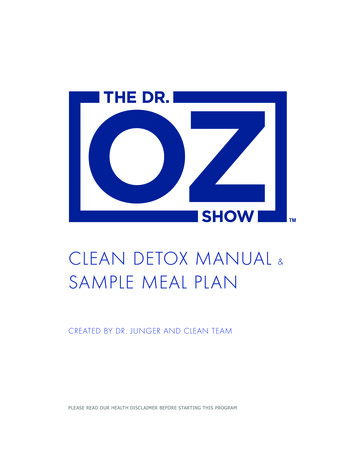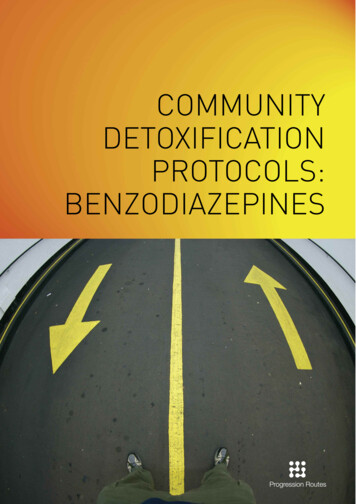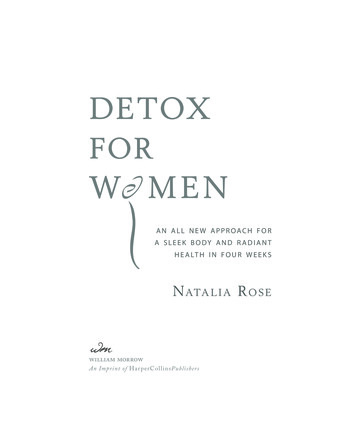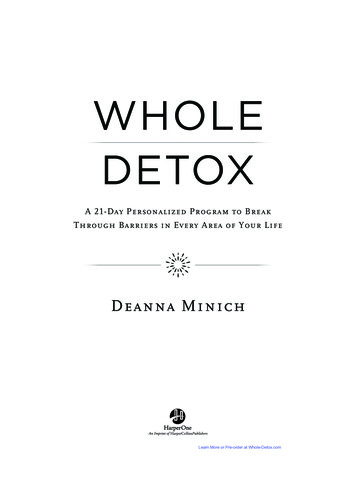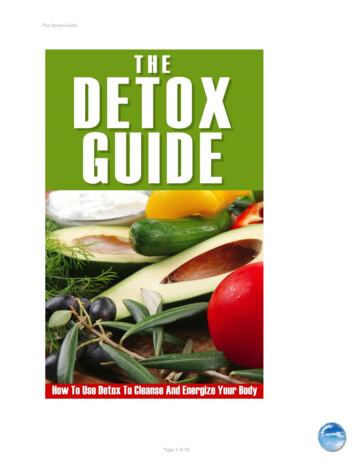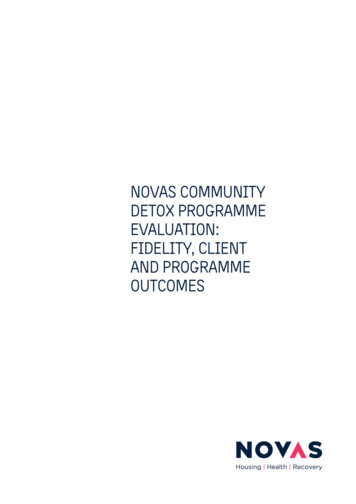
Transcription
NOVAS COMMUNITYDETOX PROGRAMMEEVALUATION:FIDELITY, CLIENTAND PROGRAMMEOUTCOMES
NOVAS COMMUNITYDETOX PROGRAMMEEVALUATION:FIDELITY, CLIENTAND PROGRAMMEOUTCOMESDr Ronni Michelle GreenwoodPsychology DepartmentUniversity of Limerick25 April 2016
135Foreword 7Introduction 11Fidelity Evaluation 21History and Context of NovasCommunity Detox ProgrammeEvaluation 11Team Roles, Responsibilities,and Competencies 22Key Features andQualities of ServiceDelivery 39CONTENTS02Methodology 15Data Collectionand Analysis 15——Client Case Notes 15——Quantitative Data 16——Qualitative Interviews 18Ethical Concerns 19Limitations 19Overview of SubsequentChapters 19——Broker Role 22——Keyworker Role 23Client Eligibility and Intake 25Phases of Community Detox:Engagement, Preparation, Detox,and Aftercare 25——Engagement 25——Preparation 26——Detoxification 28——Aftercare 29——Disengagement 29Conclusion 304Client Descriptions& Client Outcomes 33——Physical Health 34——Psychological and PsychiatricInformation 34——Reported Drug Preferences andDrug Use at Initial Contact 34General Appraisals of theNovas Community DetoxProgramme 39Team Governanceand Oversight 40——Adherence and Commitmentto Protocols 40Relations with other DrugServices in the Region 41Clinical Governance andManagement 41——Cost-Effectiveness andCost-Benefit Appraisals 42——Team Competencies and TeamFunctioning 42Community Supports andSystem of Supports areCongruent with FunderPriorities 43Relationships with GeneralPractitioners 43——Key Stakeholders’ Impressionsof the Programme’s Outreach toand Relationships with GPs 43——Doctors’ Experiences andImpressions of the Programme 43——Clients’ Experiences of Doctors 456Clients’ Experiencesof Novas CD 46——Jobs, Education, and Activities——of Daily Living 46——Emotional and Psychological——Support 47——Family Support 47Other Services’ Experienceof the Novas CommunityDetox 47Team’s Approach to Workingwith Clients 48——Sensitivity to Client’s PastExperiences 48——Wheel Approach to Supportsand Relapse Prevention 48——A Warm, InvitingEnvironment 49——Link Clients to Other Services 49——Team Works with Clientswho Leave and Come Back 49——Team Members’ Experiences——of the Team 49Weaknesses or Gaps in theProgramme 50Recommendations 51——Feedback to Referral Sources 51——Broader Community FocusSteering Group 51——Expansion of Suite of SupportServices 51——Expansion of Drug Services toAlcohol, other Drugs, Treatmentof Individuals with Dual Diagnosisand Dual Addictions 51——A Need for Women-specificServices 52——Sustainability 52Key Findings,Sustainment andDevelopmentcommendations 55Key Findings 55Recommendations 577Appendix 61Quantitative Data 61Qualitative Data 61
This evaluation of the Community Detox is highlyanticipated by Novas for many reasons. When we firstbegan to consider options for our service users andtheir accessibility of drug treatment services, we wereintroduced to the model of community detox treatment.We identified that it was an option that was readilyaccessible and provided an immediate response to thosewho were looking to engage in treatment around theirbenzodiazepine and methadone use. We accessed themodel through the Ana Liffey service who had designedthe protocols with Progression Routes.Novas envisaged the Community Detox as one of manypotential solutions to support homeless service users todetoxify from benzodiazepines and methadone, howeverover time the wider community in the Mid-West has beenthe main benefactor of the service. The Community Detoxin its current format is reaching many homes throughoutthe region where for one reason or another the personin addiction cannot access residential drug treatmentservices. For some they continue to care for their familiesand children and leaving for residential treatment is not anNovas Community Detox Programme EvaluationFOREWORDFOREWORDBY ANNE CRONIN7
Novas Community Detox Programme EvaluationDrug and Alcohol Forum who have funded the servicein partnership with the HSE since its inception in 2012.Without this support, we would not have as manyaccessing or remaining in the service. This model is a cleardemonstration of successful resource allocation meetingthe identified need in a community.This service sits within a range of other drug treatmentservices that attempt to offer as wide a choice as possiblefor those who want to access drug treatment. Researchshows us that when you have a wide, disperse populationwith a combination of needs, the response to meet thoseneeds also needs to be diverse. The Community Detoxholds a unique position in the Mid West’s suite of drugtreatment responses and has provided a regional andnational picture that was heretofore not present. Thosewho access this service are clear evidence of the continuedneed for bespoke services that respond to the everchanging dynamic that a drug user might find themselvesin. Our mothers, fathers, grandparents, siblings, childrenneed our support when drug treatment is requested – theNovas Community Detox is one such response that ismeeting a growing need in the region.Novas are heartened by the successful outcome of thisevaluation and take it as a green light to expand theprotocols to cover other areas of addiction that are beingincreasingly referred to the service; alcohol, cannabisand heroin to name but three. Novas has been supportingpeople with drug-related issues since we opened ourfirst low-threshold homeless service in Limerick in 2002,operating within a harm reduction model. Over the past14 years, we have developed many housing services aswell as health and recovery based initiatives. We view theCommunity Detox as a very successful health initiativethat will continue to provide routes for those who want totackle their benzodiazepine and methadone use and otherdrugs into the future.The Community Detox is a funded service and employsthree part-time staff, which is key to its success to-date.In other regions Community Detox has been offeredin a volunteer-led capacity and numbers anecdotallyhave been much lower than those referred to theNovas Community Detox. Services like this, need to beadequately resourced for solid and meaningful outcomes.Novas works very closely with the Mid West RegionalFinally, I wish to thank Ronni Greenwood for carryingout this evaluation and treating the data with the care andattention it deserved. I also want to thank the staff in theservice, without whom, it would not be as successful as itis today; Julie McKenna, Maurice Crowe and Dan Taylor.Thank You.Anne CroninNovas Community Detox Programme Evaluation8option. For others, confidence is an issue and group work(which is a feature of many programmes) is problematic.Whatever their own personal reason for accessing theCommunity Detox, over 130 people in the region havechosen to access drug treatment via this model in theperiod May 2012 to June 2015.9
01History and Context of Novas InitiativesCommunity Detox Programme EvaluationIn 2007, an Expert Group came together inDublin to discuss and respond to communitymembers’ reports that they could not access neededdetoxification services (O’Reilly, Reaper, & Redmond,2005). Then, as now, available residential detoxsupply could not meet demand. Limited fundingfor inpatient resources and intake criteria excludemany people from needed inpatient services.Outpatient detox is not an option for most ofthese individuals, because general practitionersare reluctant to provide this service for a numberof reasons, including increased risk of overdose,prescription abuse, and insufficient psychosocialsupports to facilitate outpatient detox (ProgressionRoutes, 2011). As a consequence, many membersof the community who had both need for andmotivation to detox had no means through which todo so.In response to this need, the Expert Groupformed a multidisciplinary steering committeecomposed of addictions experts. This group cametogether with Progression Routes Initiative (PRI) todraft a protocol for community-based detox. Theprotocols outline a set of minimum standards formedical and psychosocial support for community-based detox that are aligned with national strategicdocuments (e.g., Doyle & Ivanovic, 2010; HSE,2010). The minimum standards for a communitybased detoxification outlined in the protocols are:provision of interagency care planning, relapseprevention, and medical supports (ProgressionRoutes, 2011).Once the initial protocols were finalized, theywere pilot tested for 18 months beginning in April2007 in the North Inner City region of Dublin.This single-site community detox program wasevaluated in early 2009. PRI reported generallypositive client outcomes and cost effectivenessfindings (Progression Routes, 2011, p. 5). In 2010 anexpanded Community Based Detoxification SteeringGroup came together and revised the protocolin light of the pilot evaluation findings. In 2011,local and regional drugs tasks forces were invitedto participate in a national community-baseddetoxification pilot programme (Dermody & Lyons,2011; Progression Routes, 2011).In 2012, when the Midwest Regional Drug TaskForce released a Call for Expression of Interest forexperienced drugs services providers to apply forfunding for treatment and rehabilitation initiativesfor substance misusers in the Midwest Region,Novas Initiatives responded with an application forfunding to participate in the national communitydetox pilot programme on the basis of findings fromNovas Community Detox Programme EvaluationINTRODUCTIONIntroduction11
12a phenomenological study of self-detoxification (vanHout & Bingham, 2012), of the experience gainedin the first six months of the Novas CD programme,and because of the gap in services caused by alack of available funding for full residential detoxservice. With these funds, Novas Initiatives aimedto create and deliver a community detox teamwithin the umbrella of their homeless services atMcGarry House, which is a low threshold hostelaccommodation in Limerick City. At the time, asignificant number of McGarry House residentsmisused benzodiazepines but could not avail ofresidential detox services because they did notmeet eligibility criteria and because waiting listswere very long. Further, McGarry House residents’GPs were reluctant or refused to deliver outpatientdetox because of overdose risk, risk of prescriptionabuse, and lack of adequate supports.The management of Novas Initiatives proposedto create a funded, 60 hour per week service inwhich a community detox team would work withhomeless clients toward their detoxification goals. Infact, the Novas CD site proved to be the only fundedcommunity detox programme in the national pilotprogramme; all other pilot sites relied on voluntaryhours contributed from existing resources. Theidea was to deliver a service focused on homelessservices users (whether or not they receivedservices from Novas Initiatives). Novas managementaimed to deliver the Progression Routes protocolswithin an interagency approach. More specifically,the Novas Initiatives CD team would link withGPs, other drugs services, and with voluntary andstatutory bodies such as child welfare, probationservices, and community welfare officers. The teamwould complete intake assessments, evaluations,and care planning. They would also provide holistictreatments such as cognitive behavioural therapy,motivational interviewing, relapse prevention,and anxiety management. Through interagencycollaboration, the team would link clients toother resources in the community to aid relapseprevention, including job skills training, life skillstraining, resettlement, and recreation.The Novas Community Detox Team beganenrolling service users in 2012. Early on it becameapparent that the target population, residents ofMcGarry House and clients of other homelessservices did not meet the eligibility criteria asoutlined in the Progression Routes protocols, butthat there was a great need for community-basedbenzodiazepine detox services in the broaderarea covered by the Midwest Regional Drugs TaskForce. The team broadened the scope of its targetpopulation and increased its efforts to mobilizereferrals beyond the homeless population. Asa consequence, Novas Initiatives’ managementcreated additional pathways to serve the homelesspopulation’s substance misuse needs by enhancingthe role of the dual diagnosis worker in McGarryHouse, who also became a member of the Novas CDteam.Novas Initiatives’ management sought anindependent local programme evaluation to assessthe fidelity and outcomes of their communitydetox programme. Findings from this evaluationare presented and explained in this report. In thefollowing chapters, the reader will find a descriptionof the methodology used to collect data for thisevaluation (Chapter 3); a fidelity assessment(Chapter 4); client outcomes (Chapter 5); and keyfeatures and qualities of service delivery (Chapter6). Chapter 7, the final chapter, outlines the keyfindings and recommendations for programmedevelopment.REFERENCESDermody, A. & Lyons, S. (Winter 2011). The nationalcommunity detox initiative. Drugnet Ireland: Alcoholand Drug Research Newsletter, 40, 19-20.Doyle, J. & Ivanovic, J. (2010): National DrugsRehabilitation Framework Document. NationalDrugs Rehabilitation Implementation Committee.Dublin: Health Services Executive.HSE (2010). The Introduction of the Opioid TreatmentProtocol, HSE: Ireland.O’Reilly, F., Reaper, E., & Redmond, T. (2005): We’repeople too: Views of drug users on health services.Dublin.Progression Routes. (19th October 2011). CommunityDetoxification Protocols: Benzodiazepines.Van Hout, M. C., & Bingham, T. (2012). Familyand Individual Experiences of Self DetoxificationProcesses in the Mid-West. Project reportcommissioned by the Mid-West Regional DrugsTask Force.Novas Community Detox Programme EvaluationNovas Community Detox Programme EvaluationChapter 01 Introduction13
02There were five objectives for thisevaluation: 1) to collect evidence forthe fidelity of the Novas CommunityDetox to the original ProgressionRoutes Protocols; 2) to describe thepopulation of clients served by theNovas CD programme; 3) to assessthe delivery of the programme; 4)to assess the outcomes and impactof the programme; and 5) drawconclusions for sustainment anddevelopment of the programme.The evaluation design was mixedmethods. This means that qualitativedata and quantitative data werecombined in data analysis intendedto achieve the five evaluationobjectives.Data Collection and AnalysisThe data collected and analysed to compile thisreport were obtained from the following sources:CLIENT CASE NOTESIt was agreed with the CD Coordinator thatthe six months leading up to the beginning of theevaluation period would be included in the casenote review. Thirty client records were includedin this sample. These case records includedinformation about each phase of the detox processand included the team’s approach to engagement,preparation, detox, disengagement, and aftercare.Using the Detox Protocols as a guide, the followingassessment rubric was developed and used todocument the contents of each case note file:Novas Community Detox Programme EvaluationMETHODOLOGYMethodology15
Chapter 02 MethodologyTABLE 1. CASE NOTE REVIEWDIMENSIONCASE NOTE CHARACTERISTICS. . . . . . . . . . . . . . . . . . . . . . . . . . . . . . . . . . . . . . . . . . . . . . . . . . . . . . . . . . . . . . . . . . . . . . . . . . . . . . . . . . . . . . . . . . . . . . . . . . . . . . . . . . . . . . . . . . . . . . . . . . . . . . . . . . . . . . . . . . . . . . . . .TEAM ACTIVITIES AND SUPPORTS WITH CLIENTS. . . . . . . . . . . . . . . . . . . . . . . . . . . . . . . . . . . . . . . . . . . . . . . . . . . . . . . . . . . . . . . . . . . . . . . . . . . . . . . . . . . . . . . . . . . . . . . . . . . . . . . . . . . . . . . . . . . . . . . . . . . . . . . . . . . . . . . . . . . . . . . . . . . . . . . . . . . . . . . . . . . . . . . . . . . . . . . . . . . . . . . . . . . . . . . . . . . . . . . . . . . . . . . . . . . . . . . . . . . . . . . . . . . . . . . . . . . . . . . . . . . . . . . . . . . . . . . . . . . . . . . . . . . . . . . . . . . . . . . . . . . . . . . . . . . . . . . . . . . . . . . . . . . . . . . . . . . . . . . . . . . . . . . . . . . . . . . . . . . . . . . . . . . . . . . . . . . . . . . . . . . . . . . . . . . . . . . . . . . . . . . . . . . . . . . . . . . . . . . . . . . . . . . . . . . . . . . . . . . . . . . . . . . . . . . . .BROKERING STAGE. . . . . . . . . . . . . . . . . . . . . . . . . . . . . . . . . . . . . . . . . . . . . . . . . . . . . . . . . . . . . . . . . . . . . . . . . . . . . . . . . . . . . . . . . . . . . . . . . . . . . . . . . . . . . . . . . . . . . . . . . . . . . . . . . . . . . . . . . . . . . . . . . . . . . . . . . . . . . . . . . . . . . . . . . . . . . . . . . . . . . . . . . . . . . . . . . . . . . . . . . . . . . . . . . . . . . . . . . . . . . . . . . . . . . . . . . . . . . . . . . . . . . . . . . . . . . . . . . . . . . . . . . . . . . . . . . . . . . . . . . . . . . . . . . . . . . . . . . . . . . . . . . . . . . . . . . . . . . . . . . . . . . . . . . . . . . . . . . . . . . . . . . . . . . . . . . . . . . . . . . . . . . . . . . . . . . . . . . . . . . . . . .16. . . . . . . . . . . . . . . . . . . . . . . . . . . . . . . . . . . . . . . . . . . . . . . . . . . . . . . . . . . . . . . . . . . . . . . . . . . . . . . . . . . . . . . . . . . . . . . . . . . . . . . . . . . . . . . . . . . . . . . . . . . . . . . . . . . . . . . . . . . . . . . . . . . . . . . . . . . . . . . . . . . . . . . . . . . . . . . . . . . . . . . . . . . . . . . . . . . . . . . . . . . . . . . . . . . . . . . . . . . . . . . . . . . . . . . . . . . . . . . . . . . . . . . . . . . . . . . . . . . . . . . . . . . . . . . . . . . . . . . . . . . . . . . . . . . . . . . . . . . . . . . . . . . . . . . . . . . . . . . . . . . . . . . . . . . . . . . . . . . . . . . . . . . . . . . . . . . . . . . . . . . . . . . . . . . . . . . . . . . . . . . . . . . . . . . . . . . . . . . . . . . . . . . . . . . . . . . . . . . . . . . . . . . . . . . . . . . . . . . . . . . . . . . . . . . . . . . . . . . . . . . . . . . . . . . . . . . . . . . . . . . . . . . . . . . . . . . . . . . . . . . . . . . . . . . . . . . . . . . . . . . . . . . . . . . . . . . . . . . . . . . . . . . . . . . . . . . . . . . . . . . . . . . . . . . . . . . . . Status (closed or open case) Number of case note entries Included and completed forms: TOP; ICF;Record of disengagement Evidence of interagency care planning Evidence of working with client to buildskills and knowledge about drug use, risk,and relapse Medical supports – documentation of regularmedical visits Evidence of evaluation of suitability Evidence of meeting detox entryrequirements Referral to programme Contact with physician Explanation of the programme to clientand keyworker where relevant – protocolsshared, contact information shared Risk information and agreement Suggested next steps Completed Initial Referral Form Discussion of risk associated withwithdrawal, seizures and overdose Entry criteria Evidence of relapse prevention and careplanning – minimum of one hour per week Evidence of addressing barriers to detoxwith client Drug diaries Sharing of drug diaries and care plan withphysician Completed TOP formDIMENSIONDETOX STAGE. . . . . . . . . . . . . . . . . . . . . . . . . . . . . . . . . . . . . . . . . . . . . . . . . . . . . . . . . . . . . . . . . . . . . . . . . . . . . . . . . . . . . . . . . . . . . . . . . . . . . . . . . . . . . . . . . . . . . . . . . . . . . . . . . . . . . . . . . . . . . . . . . . . . . . . . . . . . . . . . . . . . . . . . . . . . . . . . . . . . . . . . . . . . . . . . . . . . . . . . . . . . . . . . . . . . . . . . . . . . . . . . . . . . . . . . . . . . . . . . . . . . . . . . . . . . . . . . . . . . . . . . . . . . . . . . . . . . . . . . . . . . . . . . . . . . . . . . . . . . . . . . . . . . . . . . . . . . . . . . . . . . . . . . . . . . . . . . .AFTERCARE STAGE. . . . . . . . . . . . . . . . . . . . . . . . . . . . . . . . . . . . . . . . . . . . . . . . . . . . . . . . . . . . . . . . . . . . . . . . . . . . . . . . . . . . . . . . . . . . . . . . . . . . . . . . . . . . . . . . . . . . . . . . . . . . . . . . . . . . . . . . . . . . . . . . .DISENGAGEMENT STAGE. . . . . . . . . . . . . . . . . . . . . . . . . . . . . . . . . . . . . . . . . . . . . . . . . . . . . . . . . . . . . . . . . . . . . . . . . . . . . . . . . . . . . . . . . . . . . . . . . . . . . . . . . . . . . . . . . . . . . . . . . . . . . . . . . . . . . . . . . . . . . . . . . . . . . . . . . . . . . . . . . . . . . . . . . . . . . . . . . . . . . . . . . . . . . . . . . . . . . . . . . . . . . . . . . . . . . . . . . . . . . . . . . . . . . . . . . . . . . . . . .EXPECTED DOCUMENTATION Commencement of detox Evidence of client adherence (or not) withdetox plan Evidence of weekly meetings with client,topic of meetings, and next plans Missed appointments Evidence of timeframe prescribed by GP Evidence of weekly meetings Evidence of working with client to preventrelapse and promote recovery Note of client disengagement behavioursMeetings missed & KW follow upEvidence of topping up and response to thisEfforts to contact clientDisengagement formNovas Community Detox Programme EvaluationNovas Community Detox Programme EvaluationPREPARATION STAGEEXPECTED DOCUMENTATION17
ChapterChapter0202 MethodologyMethodologyQUANTITATIVE DATAAll available quantitative data from clientrecords were coded and entered into an SPSS datafile. Statistical analyses were then run on inputteddata. Findings are presented in Chapter 5. See theAppendix for a full list of available quantitativedata.18Qualitative interviews were conducted in personand digitally recorded when possible. When notpossible, phone interviews were conducted andnotes taken during and after the interview. Eachrecorded interview was transcribed verbatim.These interview data were used as the basis offindings presented in Chapters 4 and 6.Individual client Interviews: The evaluatorrequested a list of clients with a range of types ofengagement with the programme, ranging fromdisengagement during the engagement periodto disengagement after full completion of theprogramme. A list of 21 names was provided bythe team to the Evaluator, who then contacted aselection of these individuals by text and by phone.Eight clients were interviewed, 5 in person and3 by phone. Three interviewees were men andfive were women. Semi-structured interviewswere constructed in consultation with the CDCoordinator. The interview guide is included theAppendix.Individual GP Interviews: The evaluatorrequested a list of GPs with varying degrees ofengagement with Novas CD. A list of 16 GPs withtheir contact details was provided by the NovasCD team. The evaluator attempted to arrange inperson interviews, which where digitally recordedand transcribed verbatim. When face-to-faceinterviews were not possible, phone interviewswere conducted. It proved to be difficult to recruitmany GPs to interviews, partly because of timingand partly because their schedules did not allowtime for this activity. Interviews were eventuallycompleted with five GPs, three by phone and twoface-to-face. A semi-structured interview guide wascreated in consultation with the CD Coordinator.Key stakeholder interviews: The CD Coordinatorprovided the Evaluator with a list of 7 KeyStakeholders to interview for this evaluation. FiveXerspedit, ut fugiasi tiumet,sandam landit acernam,ut volupta est officidendaecte arum, con nonsesitincipitam nos soluptavelia et lab incia dolupidebisaligent omnis dolorum quoinctur? Quid ut il et quidolupta tquae.of these seven Key Stakeholders were interviewed.One Key Stakeholder was on annual leave anunavailable for interview. Another Key Stakeholderexpressed interest in contributing to the evaluationbut the evaluator was not able to secure theinterview.Team member interviews: All three teammembers were interviewed on at least twooccasions. These interviews focused primarily onthe delivery of the programme at each stage of theprotocol, adherence to the protocols, relationshipswith clients, relationships with one another,workload, responsibilities, development ambitions,challenges, and constraints to delivering theprogramme. The CD Coordinator was interviewedindividually, and the two team members wereinterviewed together.Standard protocols for ethical treatment ofhuman participants were followed for everyaspect of data collection. All participants weregiven information about the purpose and natureof the interview questions. All participants wereassured that the evaluator would protect theirconfidentiality to that confidentiality is possiblegiven the nature of this evaluation. Because theinterviewees make up a small sample of a smallcommunity, it is possible that a reader of this reportcould draw some conclusion about the identityof some of the interviewees, and this limitationwas communicated to each interviewee. Thefinal draft has been approved by Key Informantswho, by dint of their role, could potentially beidentified by the information they provided. Noidentifying information about any client wasincluded in the SPSS data file or in any of the casenotes documentation. All identifying information isprotected and will be deleted/destroyed when thefinal version of this report is agreed.LimitationsAs with any evaluation, there are somelimitations to the data collected, and readers shouldkeep these limitations in mind when assessingthe findings. First, at the time of the evaluation,the team was in the midst of transferring overcase notes from a paper-based to a computerbased system. As a consequence, only the papercase notes, and not the electronic case notes, wereaccessed for review.Second, because this is a select sample ofindividuals who opted into the evaluation, thefindings may not be representative of all clients, allGPs, or all Key Stakeholders. Third, the design ofthis evaluation, which does not include any typeof pre-implementation assessment, means that it isnot possible to draw conclusions about cause-effectrelationships between the implementation of theservice and key outcomes. However, because theevaluator was able to draw on multiple sources ofdata from a wide range of individuals involved inthe project with different capacities, interests, andagendas, we can have confidence in the snapshotimage of Novas CD that emerged from the analysisfindings. A number of consistencies emergedacross the quantitative data, the case notes review,and interviews with team members, GPs, keystakeholders and clients, and are described in thisreport.Overview of Subsequent ChaptersThe findings from quantitative and qualitativeanalyses are organized into three chapters. Chapter4 presents the results of a fidelity assessmentin which information about the delivery of theprogramme from clients, Key Stakeholders, GPs,and the team are used to gauge the extent to whichthe program evidences fidelity to the originalProgression Routes Protocols. Chapter 5 includes adescription of the Novas client population and theirengagement with the services. Chapter 6 presentsfindings about the overall experience, effectiveness,and efficacy of the programme as describedby clients, team members, key stakeholder
Novas Community Detox is one such response that is meeting a growing need in the region. The Community Detox is a funded service and employs three part-time staff, which is key to its success to-date. In other regions Community Detox has been offered in a volunteer-led capacity and numbers anecdotally have been much lower than those referred to the
